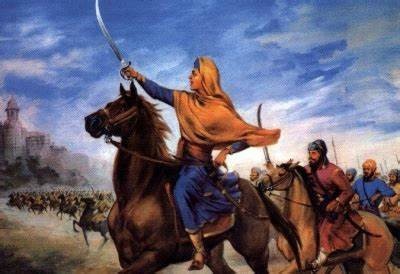Maharaja Ranjit Singh’s mother-in-law, Rani Sada Kaur (1762-1832), was the daughter of Dasaundha Singh Gill and married Gurbaksh Singh, the son of Jai Singh, the Kanhaiya clan’s chief.
Conflicts erupted among the Sikh misl chiefs as the threat of Ahmad Shah Durrani’s raids faded. In 1785, Mahan Singh Sukkarchakia assaulted Jai Singh with the support of Jassa Singh Ramgarhia and Sansar Chand Katoch. A severe battle took occurred at Achal, some 6 kilometers south of Batala, the Kanhaiyas’ seat. Jai Singh was vanquished, and Sada Kaur’s husband, Gurbaksh Singh, was murdered. Sada Kaur, a devastated yet foresighted widow, convinced her father-in-law, Jai Singh, to propose the hand of her only daughter, Mahitab Kaur, to Ranjit Singh, Mahan Singh Sukkarchakia’s five-year-old son.
Sada Kaur was the last remaining member of the triumvirate to advise and guide Ranjit Singh. She supplied him with material assistance as well, as she was now the head of the Kanhaiya misl. She assisted him in retaking Lahore from the Bhangi chiefs Mohar Singh, Sahib Singh, and [Chet Singh], from whose misrule the inhabitants had solicited the Sukkarchakkia Sardar’s protection. On July 7, 1799, Lahore fell under the joint authority of Ranjit Singh and Sada Kaur. Ranjit Singh gained more acquisitions with the help of his mother-in-law and acquired the title of Maharaja on April 11, 1801.
Sada Kaur fought alongside Ranjit Singh in the wars of Amritsar, Chiniot, Kasur, and Kangra, as well as in his excursions against the tumultuous Pathans of Hazara and Attock. Strong characters, on the other hand, caused problems, and fights between them began to develop. Sada Kaur’s daughter’s marriage to Ranjit Singh was not a joyful one. Ishar Singh, Mahitab Kaur’s first child, died in infancy. Sada Kaur greeted Ranjit Singh with twin sons, Sher Singh and Tara Singh, born to her daughter, Mahitab Kaur, upon his arrival from the cis-Sutlej campaign in 1807.
Ranjit Singh, on the other hand, had already wedded a second time, and the boy born to this relationship was recognized as the heir presumptive. This strained the mother-in-relationship law’s with her son-in-law. Sada Kaur has now begun serious negotiations with Sir Charles Metcalfe and Sir David Ochterlony to achieve her independence as a Maharani. In 1812, she further insulted the Maharaja by failing to attend the wedding of the heir apparent. Even her grandchildren, Sher Singh and Tara Singh were not allowed to attend the rituals. But at the other side of the Beas River, Ranjit Singh began to make advances into Kanhaiya territory.
When Sher Singh reached majority, Ranjit Singh requested that Sada Kaur signs over the governance of her domains to him. This was the final straw. Sada Kaur resisted, threatening to seek British protection in the cis-Sutlej realm and hand over the town of Vadhni, south of Sutlej, which Ranjit Singh had seized and transferred to her in 1808.
Sada Kaur was coerced into visiting Lahore by the Maharaja, who kept a close eye on her. She once attempted to flee in covered trash, but she was apprehended and returned. Meanwhile, the Kanhaiyas’ wealth at Atalgarh was confiscated, and their territory was sequestered. Sher Singh was given Batala as a jagir, while the rest of Sada Kaur’s holdings were given to Sardar Desa Singh Majithia to administer. Sada Kaur died in 1832 while imprisoned.
Role of women in Sikh Empire
Women play an important role in the Sikh Empire’s history. Without the protecting backing of his mother, Raj Kaur, after the death of his father, Maha Singh, when Ranjit was only ten years old, Ranjit Singh wouldn’t have become King. Raj Kaur kept the Sukerchakia misl secure for her son till he reached the age of majority. Furthermore, without the help of his in-laws, the Kanhaiya and Nakai misls, who joined him to lay siege to the Lahore Fort in 1799, Ranjit Singh might well have struggled to win Lahore. Sada Kaur, his powerful mother-in-law, was also the one who established a peace treaty with the Sikh sardars who were occupying the fort at the time, assuring that they left without causing any more bloodshed. Both of Ranjit Singh’s mother figures were significant in teaching him how to be a decent and competent leader.
Women in Sikhism had always been an integral part of the Sikh empire and played a major role in the betterment and success of Sikh rulers. In Sikhism, women have always been considered equal to men and treated with all respect. Sikhism’s teachings state that males and females have the same souls and hence have an equal right to nurture their spirituality and have a fair chance of salvation.
The lady, according to the Guru, is a vessel whereby all life enters this world. This is a one-of-a-kind role that God has bestowed upon her. In addition, the Guru regards the female to be a Princess and gives her the surname Kaur. This is only for women, and it allows them to avoid taking their husband’s name when they marry.
Many religions hold women responsible for a man’s incapacity to attain Godhood. In certain cases, this has resulted in rules dictating where women can worship and what they must wear.
The goal of Sikhism, on the other hand, is to cleanse etherealized sins and realize God via the Guru’s guidance. Once this is accomplished, God absorbs and strengthens the inner character. Thus, it is the men who enable lust to overwhelm their minds, not the females, who are to fault for any wicked thoughts that emerge within males (regardless of gender) when they view a woman.
Any woman is welcome to visit a Gurdwara (Sikh Temple) and participate in all Guru Granth Sahib prayers and recitations. Women are always a vital part of the church, and no sector is made exempt. The sole need for a woman, and even men, is that she does not wear a veil.








